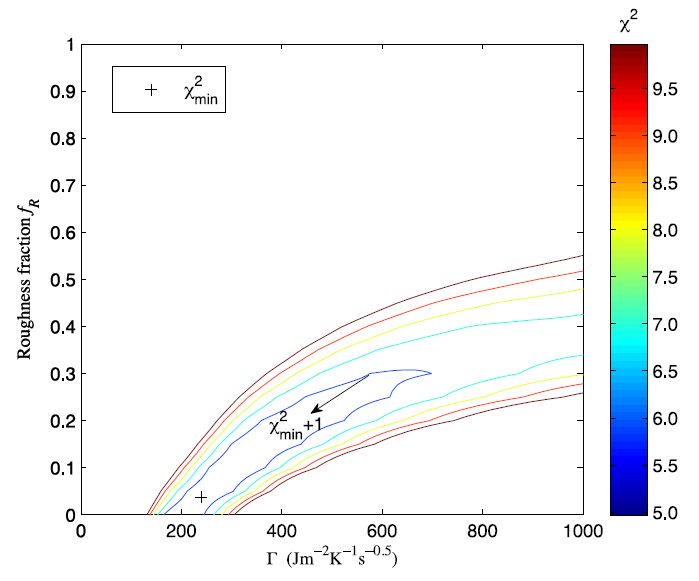July 8th 2015, Monthly Notices of the Royal Astronomical Society published the recent work of Prof. Jianghui Ji’s team, named Surface thermophysical properties determination of OSIRIS-REx target asteroid (101955) Bennu, which reveals the important physical informations about thermal inertia and grain size of the asteroid.

Figure 1 χ2 (Г, fR) contour according to Table 3. The colour (from blue to red) means the increase of profile of χ2. The blue curve labelled by χ2min + 1 is assumed to be 1σ limit to the free fit parameters (Bevington & Robingson 2003; Emery et al. 2014).
Asteroid (101955) Bennu was first found in September 11th, 1999. It is a B type Apollo group near Earth asteroid, which retains primitive substance of the early solar system. Since its orbit is very close to the orbit of Earth, Bennu is predicted to be a potential Earth impactor with a relatively high impact probability of approximately 3.7 × 10−4. In addition, the asteroid’s Yarkovsky orbit drift effect has been precisely observed with the orbital semimajor axis drift rate of -(19.0±0.1)×10-4au Myr-1. The clear orbit drift effect will change its orbit gradually, which may result in a probably impact to the Earth. Thus asteroid Bennu is widely paid attention to by lots of international astronomical research institutions, and NASA has selected Bennu as an ideal target for the OSIRIS-Rex sample return mission, which will be launched in 2016.
In order to study the orbit drift of Bennu and provide significative scientific information for OSIRIS-Rex mission, it is necessary to know Bennu’s surface properties such as albedo, roughness, and especially thermal inertia. Thermal inertia is the key quantity to describe the surface thermal state and substance chacteristics. We need, not only perfect thermal model, but also precise shape model and sufficient mid-infrared observations to figure out the above mentioned surface properties. Based on the advanced thermophysical model and the latest radar derived shape model of Bennu, with the mid-infrared data observed by Spitzer-PUI, Spitzer-IRAC, Herschel/PACS and VLT/VISIR, the planetary science research team of Purple Mountain Observatory simultaneously constrains the 1σ range of asteroid Bennu's thermal inertia, roughness fraction, and geometric albedo for the first time in the world (Figure 1), where the thermal inertia is 240+440-60Jm-2s-0.5K-1, the roughness fraction is 0.04+0.26-0.04, and the geometric albedo is 0.047+0.0083-0.0011.
According to the derived thermal inertia and the simulated temperature distribution (Figure 2), the researchers furthermore estimated the 1σ range of the surface substance’s grain size (Figure 3), probably 1.3~31 mm, which indicates that the majority surface region may be covered by regolith and merely few rocks or boulders exist. The result of this research greatly supports the feasibility of the Touch-And-Go AcquisitionMechanism designed by the OSIRIS-REx team. More importantly, the similar method can be applied to provide necessary information about the physical properties of target asteroids for the future detection mission of China.

Figure 2 The simulation of Bennu’s surface temperature distribution
The first author of this work is Liangliang Yu, research assistant of Purple Mountatin Observatory.
This work is financially supported by National Natural Science Foundation of China (grants no. 11273068, 11473073, 11403105), the Strategic Priority Research Program-The Emergence of Cosmological Structures of the Chinese Academy of Sciences (grant no. XDB09000000), the innovative and interdisciplinary program by CAS (grant no. KJZD-EW-Z001), the Natural Science Foundation of Jiangsu Province (grant no. BK20141509) and the Foundation of Minor Planets of Purple Mountain Observatory.
for more details:http://mnras.oxfordjournals.org/content/452/1/368.full
